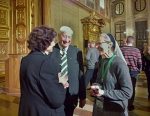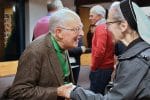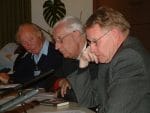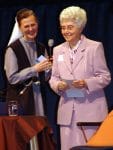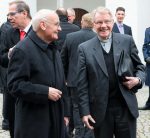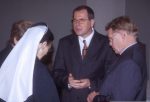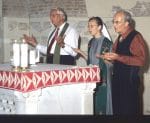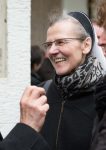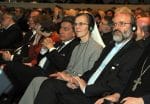
by Beatriz Lauenroth | Sep 20, 2021 | Experiences, reflections and interviews, News
The European Conference on the future of the Continent
How can one bring together 446 million persons for an exchange of ideas? The European Commission and the European Parliament have launched a digital platform to allow communication between those living in Europe. The aim of the Conference is to formulate by 2022 new responses for the future of Europe and to trace the next steps toward European integration.
This Conference is a sign of the times. The future of Europe does not depend solely on politicians; indeed, more than ever before, it depends upon the responsibility of each person.
The dialogue between European citizens started on 19 April 2021 on the online platform futureu.europa.eu. All inputs are being collected, evaluated and published in 24 official languages. This applies also for discussions regarding reform proposals.
The topics are divided into 10 categories:
- Climate change and the environment
- Health
- A stronger economy, social justice and employment
- The EU in the world
- Values and rights, rule of law, security
- Digital transformation
- European democracy
- Migration
- Education, culture, youth and sport
- Other ideas
The Conference will go on till Spring of 2022, when a commission will synthesize the final results in a report and examines how they can be put into practice in a concrete manner.
Together for Europe invites you to participate in the Conference either as a private person, or as a group in a city or as a national Committee. In this way we can put forward ideas, desires and concrete proposals for the future of Europe based on the experience of Together, which is rich in Christian values.
For further information: futureu.europa.eu
Beatriz Lauenroth
Photo: Pixabay.com

by Ada Guazzo | Sep 16, 2021 | Experiences, reflections and interviews, Italy, News
This is what the students of a Roman college had to say regarding the future of the Continent: active citizenship in Europe starts with education!
That’s quite true, and easily shown through facts! “Your elders shall have dreams, and your young people shall have visions” (Joel 3,1). When teachers offer stimuli, present ideals and reveal prospectives, young people are able to respond with enthusiasm, perspicacity and creativity. This is the case of the students of the Augusto College in Rome and their teacher Maria Paola Aloi (who supports Together for Europe).
While involved in a project regarding active citizenship in the European Union, they have identified and carefully analyzed several hot issues with the aim of putting forward solutions. Listening to a piece of classical music, the young people saw in it the metaphor of harmony in diversity in a European context, which is a shared symphony. Through a play about a girl on a boat moving toward the unknown, they censured the on-going terrible tragedies on our seas.
While delving into the myth of Europe, they recognized the roots of a culture that, in its DNA, has hospitality and the welcoming of those travelling or migrating. Using an imaginary videogame entitled ‘The Game’, they facilitated a reflection about the migrants moving along the Baltic Route. They have shown great clearness of mind when they wrote a fictitious letter to David M. Sassoli, the President of the European Parliament, in which they outlined a strategic plan regarding the ‘humanitarian corridor’ based on: Prevention, Rescue, and Welcome.
These initiatives were among those held in other colleges on May 10 to celebrate the Feast of Europe. Then they were shared on June 3 during a meeting on the platform Meet; taking part were members of the Italian network of Together for Europe (8 Italian cities; 6 Movements that adhere to Together for Europe). Irene Loffredo (Focolare), a young woman from Pozzuoli (Naples), spoke on behalf of a group that provides voluntary service at a local prison. The group is made up of members of diverse Movements and Churches. Their endeavour brought about enhanced humanization and changes. Aldo Bernabei (Followers of St Catherine) expounded the plans of the EU regarding the Erasmus project and the European Corps of Solidarity: the latter will see about 270,000 young people involved in activities of solidarity in the next few years.
We now hope to be able to propose this initiative to schools in other cities; we intend to contact teachers and to propose twinning of classes. Moreover, we will offer the help of those involved in this experience.
The European Offices in Milan and Rome were informed about this initiative. They jointly expressed their congratulations for the great commitment and care shown in the various projects that were carried out.
Dolores Librale and Ada Maria Guazzo
Photo: Pixabay
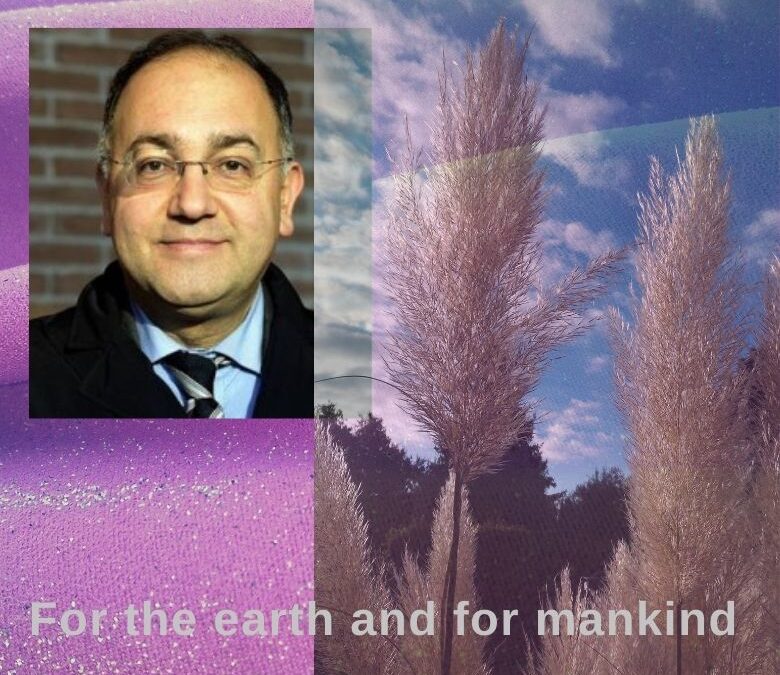
by Ada Guazzo | Jun 15, 2021 | 2021 Europe Day, Experiences, reflections and interviews, Italy, News
During a zoom conference to mark the 2021 Europe Day, Prof Luigino Bruni put forward a novel perspective regarding the relationship between ecology and economy.
Luigino Bruni is Professor of Political Economy at LUMSA, Rome, and also teaches at the University Institute Sophia in Loppiano (Florence). Moreover, he is the Scientific Director of The Economy of Francesco and President of the School of Civil Economy.
He analysed the European economy starting from its Christian roots. He then reflected upon several positive impulses that can be derived from the pandemic tragedy. He underlined the present involvement of young people which is providing new hope and a stimulus for personal commitment that combines the love of the Earth to that of Mankind.
Quite interesting was his interpretation of the quotation from Joel, 2, 28: “If the old people are still able to dream (to believe in a better world), then the young people will prophesize (they will undertake great projects)”.
Here is the transcript of the speech 09 05 2021 TfE Prof. L. Bruni – integral ecology, economy of solidarity
You can also see the video on youtube (in Italian). Click here>>
Photo: L. Bruni https://www.edc-online.org / nature: K. Brand
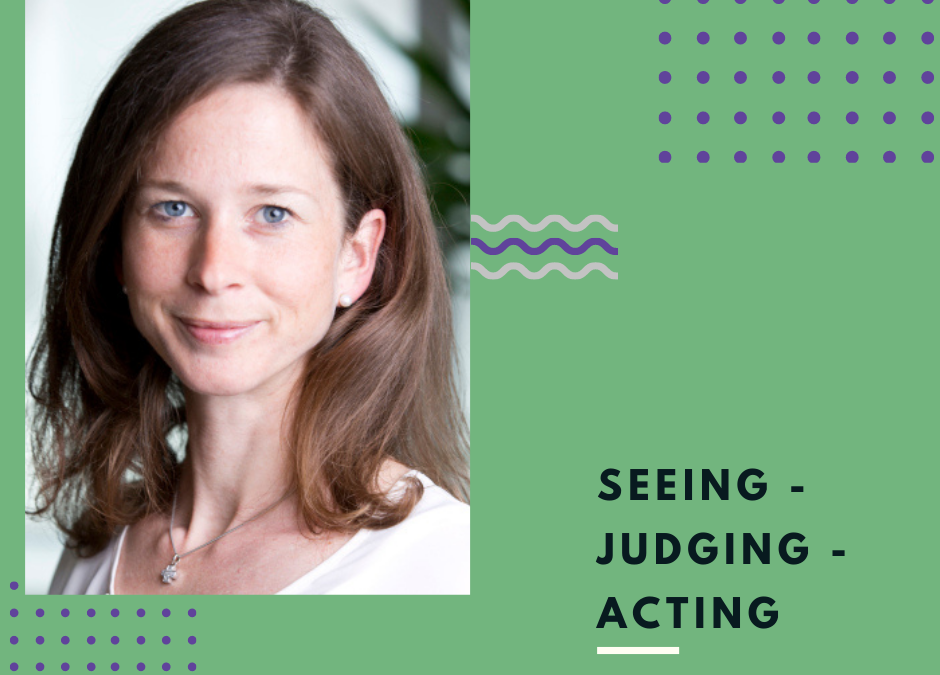
by TogetherforEurope | Jun 12, 2021 | 2021 Europe Day, Austria, Experiences, reflections and interviews, News
Europe turns 71. What can we conclude when we see that the European States, and the entire world, are struggling due to the consequences of the Pandemic?
This was the introductory question with which the Austrian professor, Dr. Petra Steinmair-Pösel, started her contribution during the Zoom conference. The conference was based in Graz and was held to mark Europe Day 2021. She quoted the Schumann Declaration (May 9, 1950): “World peace cannot be preserved without creative efforts that are as great as the threat”. According to the Professor, these words are still valid today and thus the question is: what creative efforts ought to be done by our generation?
Dr Steinmair- Pösel proposed the three steps: seeing – judging – acting. “Seeing” today’s great challenges: the pandemic, the fear of the others and therefore the building of defence walls. “Judging”: what does Europe need today? Here the Professor spoke about the need of dialogue, which is able to change life. And lastly, “Acting”, which means: to dialogue while keeping an interior silence, respecting the others and being open to learn from them.
According to Dr Steimair-Pösel, dialogue is the personal and cultural bases that allows us to seek together new solutions in a creative way; this entails nurturing mutual trust and working together. In this way we will create the conditions for “a discussion that unites us all”.
Here the transcription of her talk (translation from German) 2021 05 08 TfE Austria -Steinmair-Poesel – A conversation that brings us togehter
Photo: https://petrasteinmairpoesel.wordpress.com

by TogetherforEurope | Dec 18, 2020 | Experiences, reflections and interviews, News
Christmas is round the corner. This year’s will be extraordinary under many aspects, because humanity is still dealing with COVID-19. On March 27, 2020, in an unprecedented gesture, Pope Francis has prayed in St Pater’s Square for the end of this pandemic. The words of the Bishop of Rome seem to be relevant as never before.
Herbert Lauenroth, a member of the International Steering Committee of Together for Europe, wrote an empathetic introduction to the Pope’s words for the prayer session during the meeting of the ‘Friends of TfE’ which was held on November 14, 2020. His perspective leads us to “consolidate our own interiority […] without, however, closing ourselves inside our own home or our own identity”. (The complete text of the prayer, with the intercessions, can be downloaded from the bottom of the page).
The Lord is gracious and compassionate, slow to anger and abounding in loving devotion. The Lord is good to all; His compassion rests on all He has made (Ps 145, 8-9). The words of the psalmist lead us into this space of God; a God who wants to be recognized and implored in all his passion, his com-passion, patience and mercy, in the fidelity of his love – a Creator of all his creatures and of all creation – , which is always a ‘faithful creativity”, a “faithfulness in the future”.
Let us stand around that frail man, clothed in white, who looks somewhat lost in that immense St Peter’s Square, which was completely empty, under an insistent rain that came down on that Friday evening of March 27. Together with him let us look at the “Eternal City”, which, albeit marvellous, seems empty, abandoned, and closed in its historical sites, in its monuments, mausoleums, museums, homes, palaces, places of worship, streets and squares. All empty. Let’s stand around that one man clothed in white, whom we recognize as to be the Bishop of Rome, and therefore, our brother; that evening, however, he was also: a shepherd without his flock, “a last man standing”. Together with him, let’s give visibility to communion in Christ; together with him, let’s beseech the Real Presence of the Lord: in the midst of our communities, the various denominations, nations and as members of ethnic and cultural realities; in our midst, in the midst of humanity, and by doing so, let us, together with Pope Francis bless” –“urbi et orbi” – the city of Rome and all the cities, our Countries and the whole of Europe, a Europe that is concerned with the entire world.
Yes, let us stand around the Bishop of Rome, whom we recognize as our brother, and pushed by the COVID-19 experience, let us give visibility to the Christian Community, a community that in this time of pandemic is characterized as an experience of a Co-Immunity; a communion that comes about – paradoxically – from the regulations and experiences of “social distancing”. At a time of enhanced global communion, this crisis brutally reminds us of the necessity to consolidate our interiority, our belonging to our own Church, family, vocation and personal history – without, however, closing ourselves inside our own homes or in our own identity. It is only thus that we can rediscover our true roots, our common belonging: that of being brothers and sisters, all equal for the fact that we are unique, intimately linked and yet completely distinct from each other: we are all brothers and sisters – in Christ!
Let us, therefore, gather around as a praying community so as to resound the words of Pope Francis, and to give them meaning and efficiency; words addressed to God, in the name of the people of God, through Jesus, through Jesus in our midst, through Jesus forsaken by the Father, whose mercy and com-passion were highlighted by the words of the psalmist.
The Lord is gracious and compassionate, slow to anger and abounding in loving devotion. The Lord is good to all; His compassion rests on all He has made (Ps 145, 8-9).
2020 11 14 Friends of TfE online – Prayer in the evening, Herbert Lauenroth

by Koni Brand | Sep 10, 2020 | Experiences, reflections and interviews, News
“The music score is written in heaven; let us listen together to the Holy Spirit and then let us do what he says”. This is how Chiara Lubich defined precisely the beginning of Together for Europe (TfE). The initiators of TfE dedicated themselves unreservedly to this program. Some have already reached their final destination: Chiara Lubich (1920-2008) and Helmut Nicklas (1939-2007). Recently they were joined by Sr Anna Maria aus der Wiesche (1952-2020) and last year by Fr Michael Marmann (1937-2019).
They were persons who were so deeply rooted in their respective Church and Community that they could trustily allow the Holy Spirit to guide them into the vastness of Together for Europe. Indeed, TfE knows its existence and achievement to their courageous witnessing, trust and farsightedness.
Sr ANNA MARIA AUS DER WIESCHE, Communität Christusbruderschaft Selbitz – was a woman who, albeit sweet, was indomitable, determined and prophetically gifted [1]
Gerhard Pross, a member of the Steering Committee of TfE, writes:
Sr Anna Maria left us on August 31, 2020. It is with profound gratitude that I look back on her contribution, which lasted 20 years, toward the moulding of TfE. In the year 2000, in Germany, together with Thomas Roemer and myself, she chaired a “Meeting of Evangelical leaders”; on that occasion, Chiara Lubich and Bishop Ulrich Wilckens facilitated the great event of reconciliation between the various Confessions. Besides its birth on October 31, 1999 at Ottmaring, this was a fundamental stage for TfE and for its mission of unity. Since the very beginning, Sr Anna Maria was part of the Steering Committee of TfE; together with others she chaired the great Congresses held in Stuttgart in 2004 and 2007, as well as the reconciliation gathering between the Churches during the Munich event in 2016.
She possessed an innate aptitude for leadership. Apart from a clear vision and the capacity to integrate, she also had a well-defined spiritual vision. One of her gifts was the love of persons: she made her closeness felt to individuals, while, at the same time, she was aware of the bigger picture. Her thoughts and actions were moulded by her donation to God, her love for the Church and a life spent for unity. She discerned the signs of the times very carefully and she was always ready to welcome the common listening of what was important at that moment. Her positive outlook on life, her joy and her laughter were contagious. Sr Anna Maria leaves behind a great void. Let us keep her in our heart as a sign of our gratitude for all that we received through her.
Fr MICHAEL MARMANN – a man of communion, strong and free [2]
Just before the first great manifestation of TfE in Stuttgart in 2004, Fr Marmann stated: “We feel that this process in action in Europe is a clear sign of times. And the signs of times are God’s voices. Christianity cannot be solely a religious superstructure: it has to embrace the whole person”. In 1991, he was elected Superior General of the Schoenstatt Fathers, and, at the same time, he was also president of the General Presidium of the Movement. In this capacity, he was a pioneer of ecumenical openness and communion between Movements of diverse Churches. “He had a natural openness for an enhanced communion between spiritual Movements, especially in the network ‘Together for Europe’ (…). He was strongly convinced that the unity of the Churches and their reawakening is a decisive condition for a new vital bond between the autonomous and fragmented world and its infinite origin”.[3]
In him, Fr Heinrich Walter, saw a ‘prophetic’ attention and sympathy; “by ‘prophetic’ I mean a response to today’s challenges that goes beyond expectations, brings about synergies and triggers off un-hoped for processes”[4]. This happened even after the Pentecost vigil with John Paul II in St Peter’s square in 1998: Fr Michael immediately joined Chiara Lubich, Andrea Riccardi, Salvatore Martinez and Frances Ruppert (Cursillos de Cristiandad) to form the first nucleus of communion that the Pope wished to see between New Movements and Communities. The following year, the circle was enlarged with the members of the Communities of the Lutheran Evangelical Church: and ‘Together for…’ was born!
In 2001, a meeting was held in Munich to update the members of the Movements about the strong experience that their leaders had done. In front of 5000 persons, Chiara proposed to the audience to seal a pact of mutual love. The first to agree were Helmut Nicklas and Fr Michael Marmann. This ‘pact’ has become the basis of all that has been achieved since then through a common commitment. Thank you Father Michael!
For more information see the Video Story >>
Compiled by Cornelia Karola Brand, international secretariat of TfE
[1] From the letter of condolences of Herbert Lauenroth, Ottmaring
[2] cfr. Ekklesia, n.4 (2019/3), S.51-53
[3] Obituary by Fr Theo Breitinger, Provincial of the Schoenstatt Fathers, February 2019.
[4] cfr. Ekklesia, n.4 (2019/3), S.51-53









